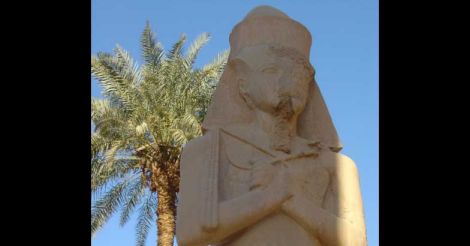India is not only a geographically and ethnically diverse nation, but is also rich in natural resources, spectacular landforms, forests, wildlife, mega biodiversity, varied agro-climatic regimes, ecosystems and majestic natural beauty. As such, the nation has been on the radar of international tourists who value the grandeur of India, visiting the country, every year in large numbers.
 Karnak Temple in Egypt: Photo: Hela Elasmer
Karnak Temple in Egypt: Photo: Hela ElasmerThe nation also proudly harbors some of the most spectacular and unique UNESCO World Heritage Sites that are known across the planet for unique landforms, ecosystems, history, archaeology and socio-cultural traditions. The other countries that house such world heritage sites include Canada, the US, Mexico, Latin American (Brazil), African (Egypt), some European countries, China, Japan, Australia and New Zealand, to name only a handful.
Some of the most beautiful places on the earth are therefore recognized under the highly prestigious UNESCO World Heritage Sites program. It not only adds to the pride, grandeur and prestige of the nation in an international platform but also opens up significant economic opportunities. These sites dotted across the planet draw tourists and visitors in large numbers, particularly international tourists who contribute towards foreign exchange earning for a nation. For the same reason, UNESCO World Heritage Sites are not just a national monument or landmass or unique ecosystem that captures the socio-cultural traditions and the practices, history, archaeology, physical geography or geology of the nation, but a significant contributor towards building local or regional economies.
 Mount Fuji : Photo: Sukrishna Ishi
Mount Fuji : Photo: Sukrishna Ishi India has huge potential to look for such potential World Heritage Sites as it has many such unique ecosystems in its extensive stretch of varied landmass. Surveys and studies need to be focused on the under explored or least explored parts of the nation like Western and Eastern Ghats region, plains, valleys and mountain ranges across Western and Eastern Himalayas, sparsely populated parts of the Himalayan foothills across Northern and Eastern India and desert areas in the West along with the heavily forested regions of the south, central, east and north east India. Parts of India that has not been well explored or exploited much, for instance, the remote border areas with poor connectivity, infrastructure and free from anthropogenic footprints could serve as potential future heritage sites.
 Hatshepsut temple in Egypt. Photo: Hela Elasmer
Hatshepsut temple in Egypt. Photo: Hela ElasmerThe ecosystems with unique landforms or geological terrains, rich biodiversity, majestic wildlife and virgin forests together with ethnic communities settled in such locations could serve as model heritage sites. Such isolated eco-zones could serve as the potential target areas, which can be transformed into important tourist destinations in the not so distant future. Unexplored and highly under developed parts of several Indian states in the north like Ladakh region of Jammu and Kashmir, western and northern frontier areas of Uttarakhand, Kinnaur, Lahaul and Spiti districts of Himachal Pradesh, Darjeeling of West Bengal and Himalayas in eastern and north east India comprising Assam, Meghalaya, Arunachal Pradesh, Nagaland, Manipur, Mizoram and Tripura could easily provide such unique ecosystem hotspots. Other potential locations could be Lakshadweep on the Arabian Sea and the Andaman and Nicobar island groups in the Andaman Sea.
Many of these potential locations could be in areas with absolute poor connectivity and infrastructure. Hence, it is important to do rigorous and comprehensive surveys and Environmental Impact Assessment (EIA) before these potential eco-heritage sites can be explored or commercially opened for both local and international tourism. There is always an underlying danger behind exposing extremely fragile and vulnerable ecosystems to anthropogenic exploitation even in the most credible or sustainable manner. Hence, it is important to be cautious with this program.
But if done with precision, planning and meticulous organization, as well as scientific management and proper objectivity, the payback can be huge in terms of both national and international recognition coupled with an economic boom. These areas have huge potential to emerge as new world heritage sites that also translates to better connectivity and infrastructure, booming economy, employment opportunities for the local resident population and opening up for lucrative local, regional and international tourism. Hence, such projects have huge future economic implications and significant economic opportunities for local communities.
Even if such sites fail to make their place in the highly prestigious UNESCO World Heritage Sites’ list, the opportunity to grow as an important tourist hub and destination is always going to be there irrespective of the final outcome. It can also positively impact the national, as well as regional, GDP growth and help build local and regional economies. India’s global competitor China has already done an excellent job in opening up such a unique ecosystems for tourism, which is significantly adding to their GDP growth and foreign exchange earning.
 Uxmal in Yucatan Peninsula, Mexico. Photo: Solorio Sanchez
Uxmal in Yucatan Peninsula, Mexico. Photo: Solorio SanchezThe opportunities are huge, but it needs to be explored carefully. Although India offers a great opportunity for global tourism, the state and union governments have explored only a very small and insignificant part of its potential, till date.
The rich ecosystems of India is currently inaccessible locations, but has the potential to transform themselves into busy tourism hubs. Of course it is important to mention that such initiatives will need a lot of partnerships to run smooth. This includes proper planning and management, along with high level monitoring and surveillance to minimize possible negative environmental impacts due to rapid anthropogenic developments and infrastructural capacity building.
(The author is a Canada and India based freelance journalist specializing in global geo-political, strategic and foreign policy issues, science & technology and environment & conservation related themes.)
Read more: Call of the Wild | Columns | Conservation of snow leopard, the most beautiful feline species

























 Andaman Cellular Jail. Photo: Saikat Kumar Basu
Andaman Cellular Jail. Photo: Saikat Kumar Basu
